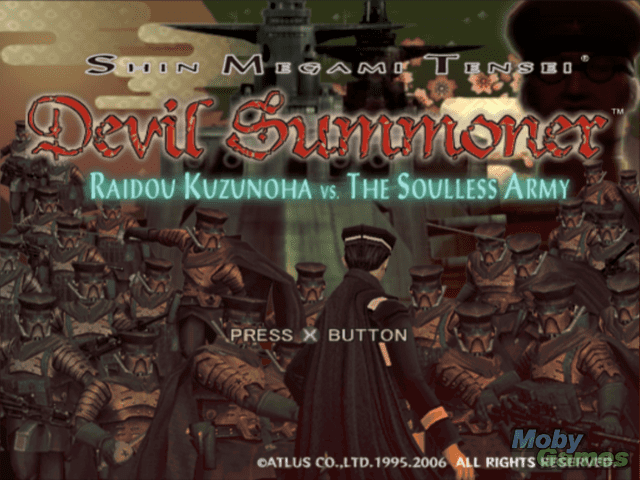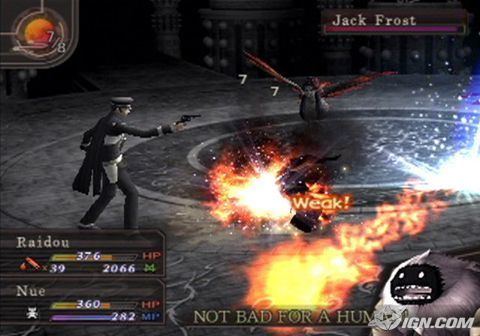8.2 /10 1 Votes
74% Metacritic Director(s) Kazuyuki Yamai Artist(s) Kazuma Kaneko Composer(s) Shoji Meguro Initial release date 2 March 2006 Developer Atlus | 74% GameFAQs 4.8/5 PlayStation Store Producer(s) Kouzou Itagaki Writer(s) Shigeo Komori Mode(s) Single-player Series Megami Tensei Genre Action role-playing game | |||||||||||||||||||||||||||||||||
 | ||||||||||||||||||||||||||||||||||
Platforms PlayStation 3, PlayStation 2 Publishers Atlus, Koei Tecmo, THQ, Koei Similar Megami Tensei games, Atlus games, Role-playing video games | ||||||||||||||||||||||||||||||||||
Shin Megami Tensei: Devil Summoner: Raidou Kuzunoha vs. The Soulless Army (Japanese: デビルサマナー 葛葉ライドウ対超力兵団, Hepburn: Debiru Samanā: Kuzunoha Raidō tai Chōriki Heidan, literally "Devil Summoner: Raidō Kuzunoha vs. The Super-Powered Army Corps") is an action role-playing game and third game in the Devil Summoner franchise, which is part of the larger Megami Tensei series of video games.
Contents

It differs from the two previous Devil Summoner titles in having real-time battles and a named protagonist and is first in the entire franchise to be set in the past – specifically the year 1931, the fictional twentieth year of the Taishō period of Japan, wherein it deals with historical figures such as Grigori Rasputin in addition to the MegaTen series' traditional use of real-world mythological figures. Though somewhat criticized for being the shortest of recent Shin Megami Tensei games, it generally received favorable responses from players and reviewers alike.

It was published by Atlus for the PlayStation 2 in 2006. On April 1, 2014, the game was ported to the PlayStation 3 as a downloadable PlayStation Store title as a PS2 Classic.

On July 30, 2008, it was announced that there would be a sequel titled Shin Megami Tensei: Devil Summoner 2: Raidou Kuzunoha vs. King Abaddon. Demon conversations make a comeback as well as Raidou being able to summon two demons simultaneously in battle. The limited edition was packaged with a new version of Shin Megami Tensei: Nocturne titled Shin Megami Tensei III: Nocturne Maniax Chronicle Edition in which Raidou appeared. The game was released in Japan on October 23, 2008 and in North America on May 12, 2009.

Combat

Unlike previous Megami Tensei titles which used turn-based battle systems, the battle system in this game is action-based. The main character can attack with either his close range sword or his long range gun (provided he has enough bullets). He can also summon one of the demons from his collection to assist him in battle. Battles themselves take place in small enclosed "arenas" similar to Namco's "Tales" series and can generally be escaped from, though this takes a random amount of time.
Fusion

Like other Megami Tensei games, Raidou Kuzunoha vs. The Soulless Army allows fusion between demons. Aside from the basic "two-for-one" fusion, a demon can also be fused into Raidou's sword, thus making the weapon more powerful.
New Game Plus
This game contains a New Game Plus feature which includes:
Characters
Story
During a routine investigation by the Narumi Detective Agency, Shohei and his teenaged apprentice Raidou Kuzunoha respond to a call for help from a client. When the client reveals herself to be Kaya Daidōji, she requests them to kill her. The two are baffled but before they can ask why, mysterious men wearing red armored suits and capes kidnap Kaya while they attack Raido to halt his pursuit.
Raidō investigates the Daidōji manor for clues before learning he must rescue Rin, a close friend of Kaya Daidōji. Raidou traverses into the Dark Realm and battles for the return of Rin. Once Rin is rescued she in turn relinquishes information about a curse within the Daidōji family. This curse causes spiritual possession that affects only females near their sixteenth birthday. Raidō then returns to the Daidōji manor to search its secret basement which is knowingly inhabited by demons only to find Kaya’s diary detailing her abduction and imprisonment by her uncle shortly before her birthday. Raidō reports back to Shouhei Narumi with detail about his investigation thus far before returning to the manor one last time to confront Kaya's uncle Kiyoshi but Kiyoshi morphs into a demon and runs away. Afterwards, the mansion gets pulled into the dark realm and Ichimokuren appears. After the battle ends Raidō is taunted by an unnamed and unseen Devil Summoner. Upon returning to headquarters Narumi and Raidou strategize on what to do next. They decide to investigate their only lead: "The Red Caped Monster".
Tae Asakura (a local reporter and friend of Narumi) stops by the Narumi Detective Agency to report a sighting of The Red Cape in Ginza-Cho and gives Raidō a photo as proof to help with his investigation. Raidō arrives at a café looking for witnesses when the owner recommends that he search out a carrier named Denpachi. Upon arriving in Fukagawa-Cho he is greeted by unfriendly thugs who suggest he enter the nearby bathhouse to request permission to search the village. After a nude showdown with two yakuza thugs the boss Satake authorizes the search but warns to that the Red Cape has been frequently sighted. Raidō is confronted at Denpachis’ home by four Soldiers and pulled into the Dark Realm where he meets an imprisoned man he must help escape. After helping Denpachi escape he refuses to give information about the Red Cape unless Raido finds his sister Shizu. Raido then goes to Satake who informs him that Shizu is working in the Red-Light District in order to accumulate the funds to pay for his medical expenses after being attacked by The Red Cape. Raido then travels back to Ginza for clues when he’s confronted by a demonic car who accuses Raido of being Red Cape that attacked him; after the battle the car gives him a ricksaw knob that according to Shizu belongs to her brother. Afterwards Raido travels to Dark Ginza to battle The Red Cape only to find that it’s in fact Denpachi. Denpachi's parting words are of the Daidouji Factory operated by Kaya's uncle Kiyoshi Daidouji. Tae then reports sighting all over the capitol of the Red Cape.
Raido reports back what he has learned thus far and Narumi informs him that Tae was also heading for the Daidouji Factory. Once Raido arrives he finds a cane that belongs to Kiyoshi Daidouji, then meets Tae before being greeted once more by the ominous unseen enemy from before. Six matryoshka begin to levitate in the room as the voice informs Raido that unless he can retrieve the three colored shards from the Matrix Labyrinth he will not see Daidouji. Once the Matrix Labyrinth is done the seal on the door confining Kiyoshi breaks. Kiyoshi prepares to divulge all information on the Daidouji family, only to begin morphing back into The Red Cape, but dies as the entity disconnects from his body and escapes. Out of the shadows steps a figure identifying himself as the Dark Summoner Rasputin. He then informs Raido that the entity he just saw was Hiruku, a demon that feeds on its hosts fear and anxiety and that Kaya is part of the next phase in his plan. Before leaving he summons one last demon from a matryoshka. Back at the detective agency the Herald of Yatagarasu stops in to warn Raido about Rasputin saying that he was thought to have died fifteen years prior and is somehow still alive and also that the strongest of Devil Summoners is no match for a Dark Summoner.
Development
Raidou Kuzunoha vs. The Soulless Army is the third entry in the Devil Summoner series, which forms part of the larger Megami Tensei series developed and published by Atlus: as with other entries, its narrative takes the form of a modern-day detective story as opposed to the series' more prevalent post-apocalyptic settings. The concept for Raidou Kuzunoha vs. The Soulless Army began in 2003, coming to producer Kazuyuki Yamai while he was feeling under pressure during the creation of the Maniax edition for Shin Megami Tensei: Nocturne. After the release and positive reception, the development team decided to move on to a project that would offer new challenges. During these discussions, multiple team members voiced their wish to create a new Devil Summoner. The initial concept was for a small-scale, low-budgeted title for a portable system, which many felt fitted with the themes and gameplay mechanics of Devil Summoner. As the scale of their ideas increased, using a portable gaming device became impractical, and so they expanded the narrative to fit their grander vision. One of the hardest parts of gameplay to perfecting the new systems, which required a lot of trial and error and multiple redrafts to the game's proposed elements. The biggest change from previous Megami Tensei titles was that demons were visibly following the player around environments. The variety of demons, which took in multiple world mythologies, also fitted in with the game's chosen setting. The music was composed by Shoji Meguro, a regular composer and sound director for the Megami Tensei series. Unlike many of his previous compositions, Meguro made heavy use of wind instrumentation and a jazzy accompaniment in tune with the game's setting. For his inspiration, Meguro drew on the soundtracks created for procedural crime dramas on television. For battle themes, he continued to use his signature guitar-heavy "MegaTen sound". Meguro also handled the recording of vocal effects for the demons. Despite being little more than odd sounds and jibberish, the sounds were recorded with professional voice actors.
The basic concept for the story as visualized by Yamai was for a modern detective drama, which fitted in with the previous games' detective story style. Unlike other entries in the Megami Tensei series, which were set in modern Japan, Raidou Kuzunoha vs. The Soulless Army was set during a fictionalized version of the Taishō period. This time period was chosen as it fitted in with the themes of coexistence the game contained as it was a period where Eastern and Western culture were in a state of uneasy coexistence. How the city's residents adapted to or resisted these changes became one of the game's narrative themes. To properly convey the period and style, the team mixed Western Art Deco buildings with city districts still using extensive architecture from the late Edo period. Pre-rendered backgrounds were used by the developers over real-time ones as they wanted a high amount of detail and ease of experience with gameplay. The game's background graphic designer Masayuki Doi did extensive research into the time period to ensure the city was as faithful as possible, although later he added buildings not present at the time due to the setting's fictionalization. Another reason for the use of pre-rendered backgrounds was that polygon-rendered backgrounds would have needed too much power. The possible use of the Taishō period as a setting originally came from discussions during the development of Devil Summoner: Soul Hackers. The Soulless Army, or in Japanese the "Super-Powered Army Corps", came about from Yamai's speculative thinking into how Japan would create supersoldiers using then-existing technology with the aim of global expansion, a sentiment dominant in Japan at the time. Their red cloaks were influenced by the urban legend of the Aka Manto.
Kazuma Kaneko, the game's character designer, wanted an exhilarating title to counter the general mood of the time, which seemed quite bleak with subjects such as declining birth rates and economy in Japan dominating the news. The main theme of the game is "passion", denoting the main protagonist's drive to protect the city from demon attacks. The character of Raidou Kuzunoha had been in Kaneko's mind since he had worked on the original Devil Summoner ten years before. When he produced the character fully formed for Yamai during a difficult period in story development, Yamai was quite relieved. The concept behind his character was a positive image that would contrast with the dark setting and storyline. The character's given name being an inherited title rather than his true name was influenced by the Shūmei ceremony from kabuki theater. The summoning tubes used by Kuzunoha were based on legends of the kuda-gitsune, a spirit that lived inside bamboo sticks. Shōhei Narumi, whose profession as private detective was still little-acknowledge at the time, was created to offer an adult perspective on events. Tae Asakura was created as Kaneko felt women of the era were somewhat neglected. Her pen name "Kichō" was inspired by Raicho Hiratsuka, a famous Japanese women's activist. They also wanted a writer-type character who could investigate the city's supernatural phenomena from a writer's perspective equivalent to the noted folklore writer Kunio Yanagita. For the character designs for the game, the team tried to stay as true as possible to clothing of the time: for instance, Kuzunoha's outfit was based on the typical Japanese male high school uniform of the time. Many of the demons used in the game were carried over from previous games for the PlayStation 2 console, but they were given revamped textures so they looked distinct from their earlier counterparts.
Release
Raidou Kuzunoha vs. The Soulless Army was first revealed in July 2005 in an issue of Famitsu under the provisional title Devil Summoner: Raidou Kuzunoha. The game's choice of subtitle styling was so that the Raidou Kuzunoha games could be distinguished from the rest of the Devil Summoner series. It was also a reference to and emulation of the novels of Japanese author Edogawa Ranpo. It was first show off in the West at the 2006 Electronic Entertainment Expo. The game's localization was handled by Atlus USA, and led by regular project leader Yu Namba. As with previous localization works, the team stayed as close as possible to the original text, although some adjustments needed to be made such as a Japanese song being changed to a more recognisable English one, and the removal of a mahjong minigame due to the total lack of a tutorial and its minor player benefits. Something unique to the localized version was the incorporation of 1920s slang into character dialogue. In Europe, the game was published by Koei. The two Raidou Kuzunoha titles received limited reprints in 2012 to commemorate the release of the 3DS port of Devil Summoner: Soul Hackers and give new players a chance to experience earlier entries in the Devil Summoner series. It was explained at the time that their release on PlayStation Network (PSN) was being delayed due to the software the Devil Summoner games were created for being incompatible with the then-current version of PSN. Raidou Kuzunoha vs. The Soulless Army eventually released on PSN on April 1, 2014.
Reception
Reception towards the game was generally positive. GameSpot rated it 7.3 out of 10, saying that it "definitely delivers on the unique storyline front, serving up a dark narrative filled with a variety of personable and powerful demons to recruit, control, and fuse." even though it was "not as polished as previous games in the series.". IGN UK rated it 7.2 out of 10, pointing out that the only flaw is with the visuals and they were "rather unappealing, and the lack of a strong plot to begin with could easily turn some people away;" however, he did praise the use of multiple demons within the historical Japanese setting.
On the other hand, the game received some high praises. For instance, Netjak rated it 9.1 out of 10. It praised the use of demons with the game's battle system and a good story. digital entertainment news rated it 8.5 out of 10, removing points based on the uneven tone and lack of voice acting.
